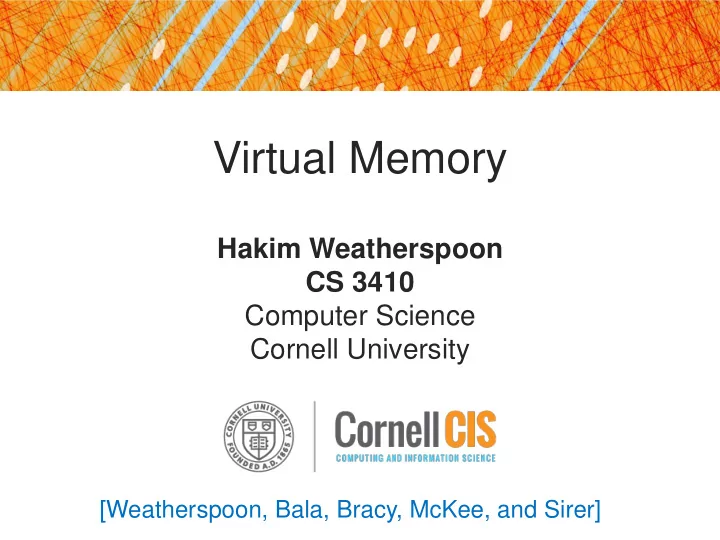

Virtual Memory Hakim Weatherspoon CS 3410 Computer Science Cornell University [Weatherspoon, Bala, Bracy, McKee, and Sirer]
Where are we now and where are we going? • How many programs do you run at once? • a) 1 • b) 2 • c) 3-5 • d) 6-10 • e) 11+ 2
Big Picture: Multiple Processes How to run multiple processes? • Time-multiplex a single CPU core (multi- tasking) • Web browser, skype, office, … all must co-exist • Many cores per processor (multi-core) or many processors (multi-processor) • Multiple programs run simultaneously 3
Processor & Memory • CPU address/data bus... • … routed through caches • … to main memory 0xfff…f CPU Simple, fast, but… 0x7ff…f Stack $$ Heap Data Text 0x000…0 Memory 4
Multiple Processes • Q: What happens when another program is executed concurrently on another 0xfff…f processor? CPU 0x7ff…f Stack Stack $$ $$ Heap Heap CPU Data Data Text Text 0x000…0 Memory 5
Multiple Processes • Q: Can we relocate second program? 0xfff…f CPU 0x7ff…f Stack Stack $$ $$ Heap Heap CPU Data Data Text Text 0x000…0 Memory 6
Big Picture: (Virtual) Memory A 3 Process 1 B 2 C 1 Give each process an D 0 illusion that it has exclusive access to entire main memory E 3 Process 2 F 2 G 1 H 0 7
But In Reality… 14 D 13 12 Process 1 E 11 10 9 C 8 7 B 6 G H 5 4 Process 2 A 3 2 F 1 0 Physical Memory 8
How do we create the illusion? 14 D 13 12 A 3 Process 1 E 11 B 2 10 C 1 9 C D 0 8 7 B 6 G H 5 E 3 4 Process 2 F 2 A 3 G 1 2 H 0 F 1 0 Physical Memory 9
How do we create the illusion? 14 D 13 12 A 3 Process 1 E 11 B 2 10 C 1 9 C D 0 All problems in computer science can be solved by another level of 8 indirection. 7 B – David Wheeler 6 G H 5 E 3 4 Process 2 F 2 A 3 G 1 2 H 0 F 1 0 Physical Memory 10
How do we create the illusion? 14 D 13 12 A 3 Process 1 E 11 B 2 10 Map virtual C 1 Physical address 9 C address to D 0 8 physical address 7 Virtual address B Memory 6 G management unit H 5 (MMU) takes care E 3 of the mapping 4 Process 2 F 2 A 3 G 1 2 H 0 F 1 Virtual Memory 0 (just a concept; does not exist physically) Physical Memory 11
How do we create the illusion? 14 Process 1 wants to D 13 access data C 12 Process 1 thinks it A 3 Process 1 E 11 is stored at addr 1 B 2 So CPU generates 10 C 1 addr 1 Physical address 9 C D 0 This addr is 8 intercepted by 7 Virtual address B MMU 6 G MMU knows this H 5 is a virtual addr E 3 MMU looks at the 4 Process 2 F 2 mapping A 3 G Virtual addr 1 -> 1 2 Physical addr 9 H 0 Data at Physical F 1 addr 9 is sent to Virtual Memory 0 CPU (just a concept; does not exist physically) And that data is Physical Memory 12 indeed C!!!
How do we create the illusion? 14 D 13 12 A 3 Process 1 E 11 B 2 10 Map virtual C 1 9 C address to D 0 8 physical address 7 B Memory 6 G management unit H 5 (MMU) takes care E 3 of the mapping 4 Process 2 F 2 3 G 1 2 H 0 1 Virtual Memory 0 A F Physical Memory 13 Disk
Big Picture: (Virtual) Memory • From a process’s perspective – Hidden from Process A 3 Process 1 B 2 C C 1 D 0 Physical Memory Virtual Memory Process only sees the virtual memory Contiguous memory 14
Big Picture: (Virtual) Memory • From a process’s perspective – Hidden from Process A 3 Process 1 B 2 C C 1 D 0 Physical Memory Virtual Memory • Process only sees the virtual memory Contiguous memory No need to recompile - only mappings need to be updated 15
Big Picture: (Virtual) Memory • From a process’s perspective – Hidden from Process C A 3 Process 1 B 2 C 1 D 0 Physical Memory Virtual Memory Process only sees the virtual memory Contiguous memory No need to recompile - only mappings need to be updated 16
Big Picture: (Virtual) Memory • From a process’s perspective – Hidden from Process A 3 Process 1 B 2 C 1 D 0 Physical Memory Virtual Memory Process only sees the virtual memory C Disk Contiguous memory No need to recompile - only mappings need to be updated When run out of memory, MMU maps data on disk in a transparent manner 17
Next Goal • How does Virtual Memory work? • i.e. How do we create the “map” that maps a virtual address generated by the CPU to a physical address used by main memory? 18
Next Goal (after spring break!) • How does Virtual Memory work? • i.e. How do we create the “map” that maps a virtual address generated by the CPU to a physical address used by main memory? 19
Virtual Memory Agenda What is Virtual Memory? How does Virtual memory Work? • Address Translation • Overhead • Paging • Performance 20
Recommend
More recommend